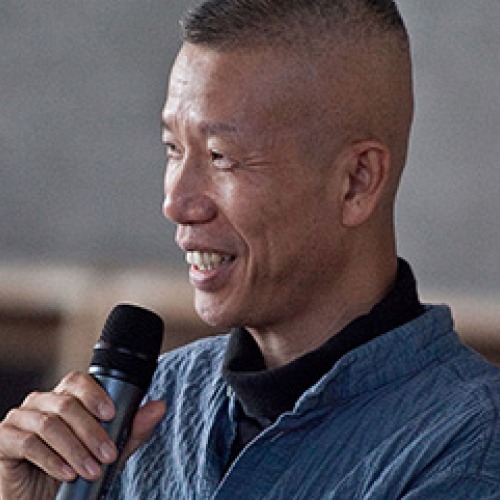GUO-QIANG
Cai Guo-Qiang was born in 1957 in Quanzhou City, Fujian Province, China. He was trained in stage design at the Shanghai Theater Academy, and his work has since crossed multiple mediums within art, including drawing, installation, video and performance art. While living in Japan from 1986 to 1995, he explored the properties of gunpowder in his drawings, an inquiry that eventually led to his experimentation with explosives on a massive scale and to the development of his signature explosion events. Drawing upon Eastern philosophy and contemporary social issues as a conceptual basis, these projects and events aim to establish an exchange between viewers and the larger universe around them, utilizing a site-specific approach to culture and history.
Cai was awarded the Japan Cultural Design Prize in 1995 and the Golden Lion at the 48th Venice Biennale in 1999. In the following years, he has received the 7th Hiroshima Art Prize (2007), the 20th Fukuoka Asian Culture Prize (2009), and AICA’s first place for Best Project in a Public Space for Cai Guo-Qiang: Fallen Blossoms (2010). He also held the distinguished position as Director of Visual and Special Effects for the opening and closing ceremonies of the 2008 Summer Olympics in Beijing. In 2012, Cai was honored as one of five Laureates for the prestigious Praemium Imperiale, an award that recognizes lifetime achievement in the arts in categories not covered by the Nobel Prize. Additionally, he was also among the five artists who received the first U.S. Department of State - Medal of Arts award for his outstanding commitment to international cultural exchange.
Among his many solo exhibitions and projects include Cai Guo-Qiang on the Roof: Transparent Monument, Metropolitan Museum of Art, New York, 2006 and his retrospective I Want to Believe, which opened at the Solomon R. Guggenheim Museum, New York in February 2008 before traveling to the National Art Museum of China in Beijing in August 2008 and then to the Guggenheim Bilbao in March 2009. In 2011, Cai appeared in the solo exhibition Saraab at Mathaf: Arab Museum of Modern Art in Doha, Qatar, his first ever in a Middle Eastern country. In 2012, the artist appeared in three solo exhibitions: Sky Ladder (The Museum of Contemporary Art, Los Angeles), Spring (Zhejiang Art Museum, Hangzhou, China), and A Clan of Boats (Faurschou Foundation, Copenhagen, Denmark).
His first-ever solo exhibition in Brazil, Cai Guo-Qiang: Da Vincis do Povo, went on a three-city tour around the country in 2013. Traveling from Brasilia to São Paulo before reaching its final destination in Rio de Janeiro, it was the most visited exhibition by a living artist worldwide that year with over one million visitors. In October 2013, Cai created One Night Stand (Aventure d’un Soir), an explosion event for Nuit Blanche, a citywide art and culture festival organized by the city of Paris. In November 2013, his solo exhibition Falling Back to Earth opened at the Queensland Art Gallery | Gallery of Modern Art in Australia. In 2014, he created solo exhibitions The Ninth Wave at the Power Station of Art in Shanghai and Impromptu at Fundación Proa, in Buenos Aires. On January 24, 2015, he realized Life is a Milonga: Tango Fireworks for Argentina in the neighborhood of La Boca.
His most recent solo exhibition There and Back Again opened on July 11, 2015 at the Yokohama Museum of Art in Japan. Cai is currently participating in the 2015 Echigo-Tsumari Triennial with the solo exhibitions Penglai / Hōrai (open July 26) at the Satoyama Museum of Contemporary Art and Art Island at the Art Front Gallery, Tokyo (open July 27) and curating DMoCA 6: Thrown Rope for Japan – Peter Hutchinson in Tsunan Mountain Park, Niigata (open July 26).
Cai was the curator of the first China Pavilion at the 51st Venice Biennale in 2005. Since 2000, he has also converted unexpected spaces into small-scale exhibition venues for rural communities and small towns in different parts of the world. This Everything is Museum series includes: DMoCA (Dragon Museum of Contemporary Art , 2000) in Tsunan Mountain Park, Niigata Prefecture, Japan; UMoCA (Under Museum of Contemporary Art, 2001) in Colle di Val d’Elsa, Tuscany, Italy; BMoCA (Bunker Museum of Contemporary Art, 2004) on Kinmen Island, Taiwan; and SMoCA (Snake Museum of Contemporary Art, 2013) in Iwaki, Fukushima Prefecture, Japan.
He currently lives and works in New York.
-
NameCAI GUO-QIANG







